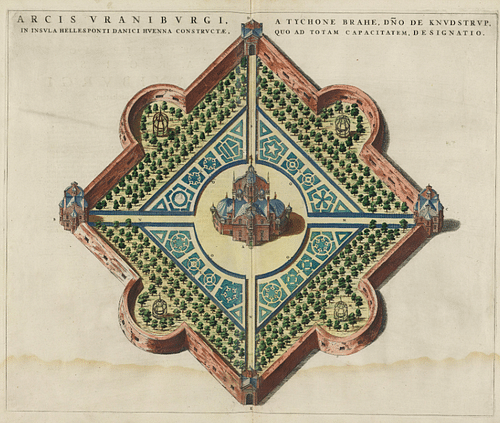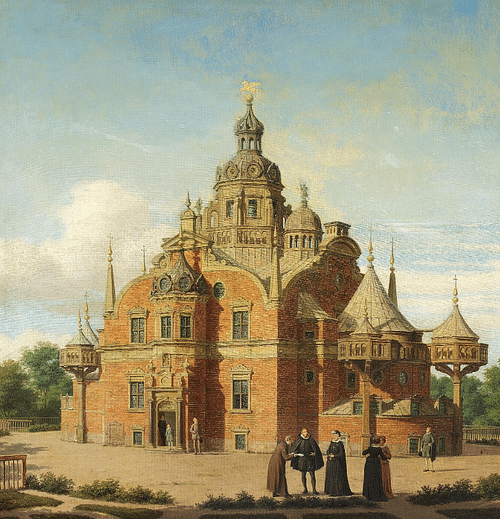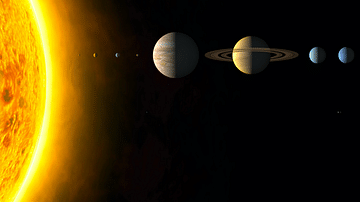
Tycho Brahe (1546-1601) was a Danish nobleman who made the most significant contribution to our knowledge of astronomy before the telescope arrived. He discovered a supernova, observed the elliptical interplanetary orbit of a comet, updated the accuracy of the calendar, and proposed a whole new theory of the positions of the heavenly bodies in the night sky.
Early Life
Tyge Brahe was born on 14 December 1546 in Skåne (aka Scania, modern Sweden), which was then ruled by the Danish Crown. He is today better known by his Latinized name Tycho Brahe, most often simply as Tycho. He was born into a noble family with connections to the royal family of Sweden. Tycho attended the University of Copenhagen, where he studied law before moving to Germany, where he continued his studies at the universities of Wittenberg, Leipzig, and Rostock, amongst others. He got himself into a duel with a fellow student in Germany, and although he survived the encounter, most of his nose did not. For the rest of his life, Tycho wore an artificial nose made of metal – brass for everyday use but with a more resplendent version made of silver coming out on special occasions.
Tycho's Supernova
Tycho first became interested in astronomy when he observed the total eclipse on 25 August 1560. His first published work of note was De Nova Stella (1573). The book was on the subject of the new star supernova in the Cassiopeia constellation (much brighter than any other star in that group, brighter even than Venus), which he was the first to observe and study in detail on 11 November 1572. The supernova, one of only a handful in history which could be seen both at night and during the day with the naked eye, was clearly visible for at least five months. The remnants of what is really the death throes of a star, the supernova can still be seen using an X-ray telescope and has been named Tycho's Supernova.
Tycho was able to measure the proximity or parallax of this new star in relation to Earth by measuring it at different times (since the stars rotate in the night sky, Tycho was effectively measuring two angles of a triangle with himself at one point and the star at another). By calculating its distance from Earth, he demonstrated that the star was much further away than the Moon, a concept that shook the prevailing view of the cosmos. Even more significantly, the facts that the star had appeared at all, was a heavenly body of some sort, and had nothing to do with Earth's atmosphere all meant that the universe was a changing entity, a crushing blow to the long-held belief that the universe was perfect and unchanging.
Uraniborg
As a reward for his astronomy work, King Frederick II of Denmark and Norway (r. 1559-1588) gave the astronomer his own island, Hven, in 1576. Hven, today called Ven and located in the Öresund Strait between Sweden and Denmark, was perfect for Tycho since here he could build his own observatory, helped with generous funding from the Danish Crown. Tycho called his observatory Uraniborg, which was named after Urania, the Greek muse of astronomy, and which translates as "the fortress of Urania". The complex was indeed built like a fortress, with the observatory set in the centre of symmetrical gardens, which were enclosed on all sides behind high walls with entrances only at each of the corners.
Uraniborg permitted Tycho to make systematic observations of the night skies, which he made using instruments he himself had designed and built, including the new astronomical sextant. Perhaps the most impressive of these instruments was a massive mural quadrant on the west wall of his observatory. Tycho later created an illustrated book on all the astronomical instruments in his observatory, his Instruments for the Restoration of Astronomy, published in 1598. The Jesuit missionary Ferdinand Verbiest (1623-1688) famously used this book to build instruments for the imperial observatory in Beijing in the 1670s.
The main building of Uraniborg was an extravagant structure bristling with platforms, towers, and spires, a mix of fantasy that would not have looked out of place in Arabian Nights or at Xanadu. There was a workshop dedicated to the manufacturing of scientific instruments. It had its own paper mill and printing press to publish Tycho's research. There was also a laboratory down in the basement where Tycho indulged his other great interest: alchemy.
Uraniborg became a tourist attraction in itself, and as Tycho's reputation increased, so did the social level of the visitors. The future James I of England (r. 1603-1625) visited while on a trip to secure his bride Anne of Denmark (b. 1574), the daughter of Frederick II. Tycho was regularly assisted in his work at Uraniborg by his wife Kirstine (m. 1573) and his sister Sophie (1559-1643). He was also assisted by his labourers, who were treated little better than medieval serfs. Tycho expected the local peasantry to work on his estate for two days each week. When Tycho left Uraniborg in 1597, the observatory fell into decay.
Achievements & the Tychonic Model
Tycho's extensive observations allowed him to catalogue the positions of the stars and planets more accurately than had ever been done before. He shared this data with only a select few since he did not want a rival to present theories he was himself only just formulating. Some data was released for the public good. He took countless observations of the Sun and recalculated the true length of the year, a study that resulted in a wholesale change to the calendar to make it more accurate in 1582 (a reform that replaced the old Julian calendar with the Gregorian calendar). Tycho completed a star catalogue, which positioned over 800 stars. This was the first new catalogue since that produced by Ptolemy (c. 100 to c. 170 CE). In 1603, Tycho's catalogue was made into an atlas of the stars by Johann Bayer (1572-1625)
Back in 1577, Tycho's detailed observation of the comet sighted that year showed that it moved in an orbit that passed between the planets. Further evidence of this phenomenon came with observation of the 1580 and 1585 comets. This was a blow to models of the universe which had everything moving around the Earth. The Greek natural philosopher Aristotle (384-322 BCE) had claimed that comets were a phenomenon of Earth's atmosphere, but Tycho's research now disproved this long-held belief. The comets also seemed to follow an elliptical orbit, yet another blow to the entrenched belief that all heavenly bodies moved in perfect circles. These newly discovered facts and his previous work on the new supernova – clear evidence that there was change when Aristotle had claimed the cosmos was eternally stable – meant that the old Aristotelian view of the universe began to crumble. For some historians, this was the true beginning of the Scientific Revolution, when observation began to test long-held and obviously incorrect theories.
These discoveries were all very important in the longer-term view of the progression of science, but Tycho's main contribution to world knowledge at the time was something else, here summarised by the historian W. E. Burns:
Tycho's greatest contribution to astronomical theory was the Tychonic model of the solar system, based on a stationary Earth; in this system, the Moon and Sun orbit the Earth and the other planets orbit the Sun. (42)
Tycho, therefore, overturned the alternative two models suggested by Ptolemy (c. 100 to c. 170 CE) and Nicolaus Copernicus (1473-1543 CE). The Tychonic system helped do away with Ptolemy's wholly geocentric model and became a sort of compromised rival to Copernicus' fully heliocentric model. Tycho published his theory (which turned out to be wrong, of course) in his Of More Recent Phenomena of the Ethereal World, published in 1588.
Like just about every other scientist in this period, Tycho got into a heated dispute with a fellow thinker over who had thought of what first. In Tycho's case, his enemy was the German astronomer Nicolaus Reimers Bär (1551-1600), also known as Ursus (the Bear). Tycho accused Ursus of copying his theory of the cosmos, done when he visited Uraniborg. Tycho also claimed it was he and not Ursus who "invented the mathematical technique of prosthaphaeresis, which was important for making lengthy calculations before the invention of logarithms" (Wootton, 94).

Prague & Final Years
Tycho's aristocratic status had helped him enormously in his chosen career, but it turned out to be a severe handicap from 1596 when King Christian IV of Denmark (r. 1588-1648) came of age and ruled without his regent. The young monarch was keen to balance his books and take more careful control of where royal money was spent. Even worse for Tycho, the king wanted to reduce the power of certain noble families, and so the astronomer fell out of favour. Obliged to leave Uraniborg in 1597, Tycho hopped about various spots in Germany for two years and finally ended up in Prague, then the capital of the Holy Roman Empire. Unfortunately, his old enemy Ursus was already well entrenched in the Bohemian city and held the prestigious position of court mathematician. Ursus did his best to trash Tycho's reputation, but the Dane managed to gain favour with Rudolf II, Holy Roman Emperor (r. 1576-1612), and so was able to steal Ursus' position.
Tycho was fortunate to have a rare talent as his assistant in Prague, one Johannes Kepler (1571-1630), who went on to become one of the most important figures of the Scientific Revolution. Tycho was keen to extend his star catalogue to include more southern stars, and to that end, he made contact with both the Venetians and Tuscans in the hope that one of them would come up with the funds for a new observatory in Egypt. Neither state responded favourably. Tycho had a similar lack of success with another Italian, the astronomer Galileo Galilei (1564-1642), whom he wrote to twice to propose a collaboration but each time was ignored. Galileo had no time for theoretical models of the universe and preferred pure observation; around 1608, Galileo would perfect the new invention of the telescope and make his own impressive catalogue of discoveries.
On 24 October 1601, Brahe died in Prague. Kepler succeeded Tycho, and crucially, he inherited his extensive and highly accurate observations of the movements of the heavenly bodies. Kepler put this data to good use, especially Tycho's notes on the movement of Mars, and formed his celebrated three laws of planetary motion.
Tycho's belief that measurements must be continuously taken to continuously improve accuracy became one of the founding principles of modern science, and it is why many have called Tycho "the true founder of the new astronomy" (Wootton, 456) and claim that astronomy became the first modern science. Above all, Tycho demonstrated that theories were not more valuable simply because they had been believed for a long time. Further, he demonstrated that believing one wrong theory often led to believing other wrong theories, creating catastrophic chains of error. In observing what was to be seen, not what he hoped to see, Tycho was one of the first of what we would today call a proper scientist, that is, someone who investigates a subject without preconceived ideas of what those investigations might show to be true, an investigator who reconciles theory, phenomena, and data to increase our knowledge of the world around us.








